Symbolism and Traditions
Develop an understanding of First Nations, Métis and Inuit cultural symbolism and traditions.
To begin, select a category from the menu.
As you explore symbolism associated with convocation from the Faculty of Education at the University of Alberta, you will see some First Nations, Métis and Inuit symbols that have been incorporated into these ceremonies. This parallels the First Nations, Métis and Inuit traditions of recognizing that individual achievements contribute to the benefit of the whole community.
Julie-Anne tells her homeroom that she will be away on Monday attending her convocation.
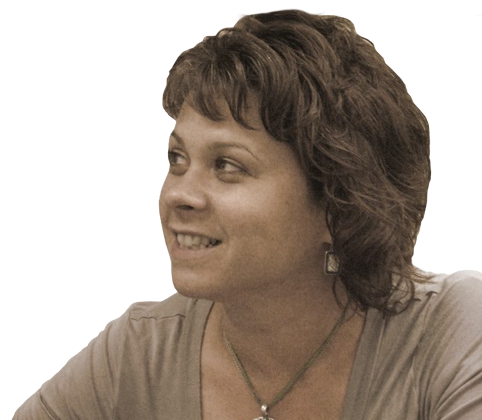
A teacher from Southern Alberta, Julie-Anne will be receiving her Master’s degree in Fine Arts. Julie-Anne mentions that when she receives her scroll or degree, she will wear a gown, cape and mortarboard, as well as a Métis sash in honour of her Métis heritage. One student shares that upon graduation, his cousin received an eagle feather in honour of their First Nations culture. Julie-Anne and her students begin a discussion on the meaning of these symbols and First Nations, Métis and Inuit cultural expressions of identity and pride.
Make a Selection.
| University of Alberta | Bachelor’s Degree in Education (B.Ed.) | Master’s Degree in Education (M.Ed.) | Doctorate Degree in Education (Ph.D. & Ed.D.) |
|---|---|---|---|
|
First Nations
|
   First Nations B.Ed. |
    First Nations M.Ed. |
    First Nations Ph.D. & Ed.D |
|
Métis
|
   Métis B.Ed. |
   Métis M.Ed. |
   Métis Ph.D. & Ed.D |
|
Non-Aboriginal
|
  Non-Aboriginal B.Ed. |
  Non-Aboriginal M.Ed. |
  Non-Aboriginal Ph.D. & Ed.D |
Non-Aboriginal — Bachelor’s Degree in Education (B.Ed.)
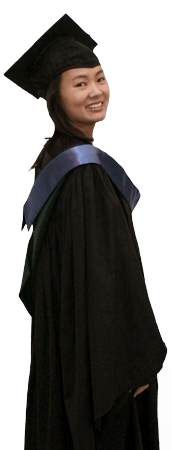

Cap (Mortarboard)
The cap or mortarboard is a universally accepted symbol of academia, with Middle Eastern roots. U of A mortarboards are the standard black trencher shape with black tassels, which are worn forward and to the left.

Gown
The convocation gown is a traditional garment signifying higher learning that dates back to medieval times. All U of A gowns are the customary Cambridge shape: a gown of black material falling below the knee with full sleeves cut to the elbow and terminating in a point.
Hood
Originally a functional garment worn to shield the head from the elements, the hood has become ceremonial. The Faculty of Education Master’s hood has a full lining and a border three inches wide in royal blue.
Non-Aboriginal — Master’s Degree in Education (M.Ed.)
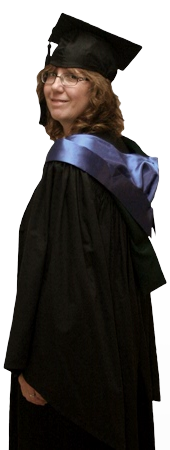

Cap (Mortarboard)
The cap or mortarboard is a universally accepted symbol of academia, with Middle Eastern roots. U of A mortarboards are the standard black trencher shape with black tassels, which are worn forward and to the left.

Gown
The convocation gown is a traditional garment signifying higher learning that dates back to medieval times. All U of A gowns are the customary Cambridge shape: a gown of black material falling below the knee with full sleeves cut to the elbow and terminating in a point.
Hood
Originally a functional garment worn to shield the head from the elements, the hood has become ceremonial. The Faculty of Education Master’s hood has a full lining and a border three inches wide in royal blue.
Non-Aboriginal — Doctorate Degree in Education (Ph.D & Ed.D.)
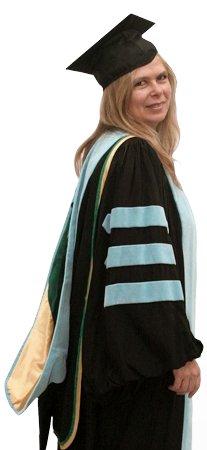

Cap (Mortarboard)
The cap or mortarboard is a universally accepted symbol of academia, with Middle Eastern roots. U of A mortarboards are the standard black trencher shape with black tassels, which are worn forward and to the left.

Gown
Doctors’ gowns (Ph.D. and Ed.D.) conform to the Intercollegiate Code in design. They are made of black material, and the velvet trim on the sleeves is Philosophy Blue for the Ph.D. and Education Light Blue for the Ed.D.
Hood
Doctors’ hoods conform to the Intercollegiate Code in design. They are made of black material to match the gown and have a full lining of gold satin with a six-inch green satin chevron. The velvet trim distinguishes the two degrees and matches the velvet trim on the gown’s sleeves (Philosophy Blue for the Ph.D. and Education Light Blue for the Ed.D.). There is a narrow green piping where the gold lining joins the black material.
First Nations — Bachelor’s Degree in Education (B.Ed.)
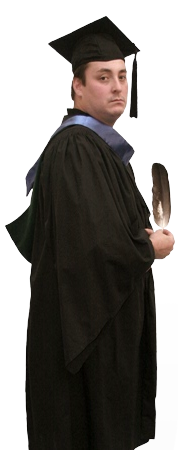

Cap (Mortarboard)
The cap or mortarboard is a universally accepted symbol of academia, with Middle Eastern roots. U of A mortarboards are the standard black trencher shape with black tassels, which are worn forward and to the left.

Gown
The convocation gown is a traditional garment signifying higher learning that dates back to medieval times. All U of A gowns are the customary Cambridge shape: a gown of black material falling below the knee with full sleeves cut to the elbow and terminating in a point.
Hood
Originally a functional garment, worn to shield the head from the elements, the hood has become ceremonial. The Faculty of Education Bachelor’s hood has a border three inches wide in royal blue.

Eagle Feather
The eagle flies closest to the Creator, so an eagle feather is presented on behalf of the community to acknowledge courage, bravery, wisdom and accomplishment.
First Nations — Master’s Degree in Education (M.Ed.)
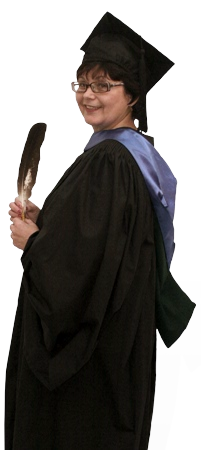

Cap (Mortarboard)
The cap or mortarboard is a universally accepted symbol of academia, with Middle Eastern roots. U of A mortarboards are the standard black trencher shape with black tassels, which are worn forward and to the left.

Gown
The convocation gown is a traditional garment signifying higher learning that dates back to medieval times. All U of A gowns are the customary Cambridge shape: a gown of black material falling below the knee with full sleeves cut to the elbow and terminating in a point.
Hood
Originally a functional garment worn to shield the head from the elements, the hood has become ceremonial. The Faculty of Education Master’s hood has a full lining and a border three inches wide in royal blue.

Eagle Feather
The eagle flies closest to the Creator, so an eagle feather is presented on behalf of the community to acknowledge courage, bravery, wisdom and accomplishment.

Blanket
Just as newborns are wrapped in a blanket of security and love, graduates are embraced by the community. The gift of a blanket symbolizes the community’s pride in an individual and their willingness to give continuing support.
First Nations — Doctorate Degree in Education (Ph.D & Ed.D.)
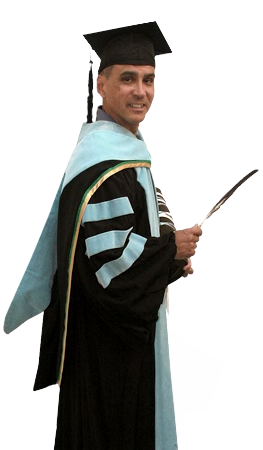

Cap (Mortarboard)
The cap or mortarboard is a universally accepted symbol of academia, with Middle Eastern roots. U of A mortarboards are the standard black trencher shape with black tassels, which are worn forward and to the left.

Gown
Doctors’ gowns (Ph.D. and Ed.D.) conform to the Intercollegiate Code in design. They are made of black material, and the velvet trim on the sleeves is Philosophy Blue for the Ph.D. and Education Light Blue for the Ed.D.
Hood
Doctors’ hoods conform to the Intercollegiate Code in design. They are made of black material to match the gown and have a full lining of gold satin with a six-inch green satin chevron. The velvet trim distinguishes the two degrees and matches the velvet trim on the gown’s sleeves (Philosophy Blue for the Ph.D. and Education Light Blue for the Ed.D.). There is a narrow green piping where the gold lining joins the black material.

Eagle Feather
The eagle flies closest to the Creator, so an eagle feather is presented on behalf of the community to acknowledge courage, bravery, wisdom and accomplishment.

Blanket
Just as newborns are wrapped in a blanket of security and love, graduates are embraced by the community. The gift of a blanket symbolizes the community’s pride in an individual and their willingness to give continuing support.
Métis — Bachelor’s Degree in Education (B.Ed.)
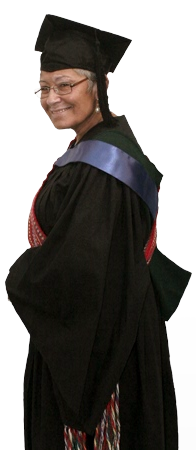

Cap (Mortarboard)
The cap or mortarboard is a universally accepted symbol of academia, with Middle Eastern roots. U of A mortarboards are the standard black trencher shape with black tassels, which are worn forward and to the left.

Gown
The convocation gown is a traditional garment signifying higher learning that dates back to medieval times. All U of A gowns are the customary Cambridge shape: a gown of black material falling below the knee with full sleeves cut to the elbow and terminating in a point.
Hood
Originally a functional garment, worn to shield the head from the elements, the hood has become ceremonial. The Faculty of Education Bachelor’s hood has a border three inches wide in royal blue.

Sash
The original Métis sash was a multi-functional item that signified identity and was used in practical ways. The sash is presented to remind graduates to be proud of their Métis identity and to honour their accomplishment.
Métis — Master’s Degree in Education (M.Ed.)
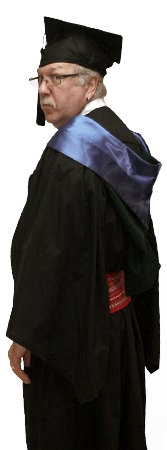

Cap (Mortarboard)
The cap or mortarboard is a universally accepted symbol of academia, with Middle Eastern roots. U of A mortarboards are the standard black trencher shape with black tassels, which are worn forward and to the left.

Gown
The convocation gown is a traditional garment signifying higher learning that dates back to medieval times. All U of A gowns are the customary Cambridge shape: a gown of black material falling below the knee with full sleeves cut to the elbow and terminating in a point.
Hood
Originally a functional garment worn to shield the head from the elements, the hood has become ceremonial. The Faculty of Education Master’s hood has a full lining and a border three inches wide in royal blue.

Sash
The original Métis sash was a multi-functional item that signified identity and was used in practical ways. The sash is presented to remind graduates to be proud of their Métis identity and to honour their accomplishment.
Métis — Doctorate Degree in Education (Ph.D & Ed.D.)
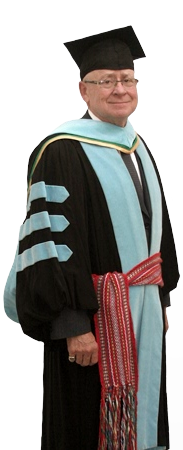

Cap (Mortarboard)
The cap or mortarboard is a universally accepted symbol of academia, with Middle Eastern roots. U of A mortarboards are the standard black trencher shape with black tassels, which are worn forward and to the left.

Gown
Doctors’ gowns (Ph.D. and Ed.D.) conform to the Intercollegiate Code in design. They are made of black material, and the velvet trim on the sleeves is Philosophy Blue for the Ph.D. and Education Light Blue for the Ed.D.
Hood
Doctors’ hoods conform to the Intercollegiate Code in design. They are made of black material to match the gown and have a full lining of gold satin with a six-inch green satin chevron. The velvet trim distinguishes the two degrees and matches the velvet trim on the gown’s sleeves (Philosophy Blue for the Ph.D. and Education Light Blue for the Ed.D.). There is a narrow green piping where the gold lining joins the black material.

Sash
The original Métis sash was a multi-functional item that signified identity and was used in practical ways. The sash is presented to remind graduates to be proud of their Métis identity and to honour their accomplishment.
Reflection Statement
Symbols and traditions reflect the values and beliefs of a culture and its people. Evolving over time, symbols and traditions vary among First Nations, Métis and Inuit and are central to a group’s identity and way of life.
What symbols and traditions do you and your students bring to the classroom?
Xavier Batoche, Métis Elder and artisan, speaks about the roots of Métis culture.
The speakers in these interviews share their diverse perspectives on enduring First Nations and Métis cultural practices, traditional teachings and valued symbols.
Select a video.
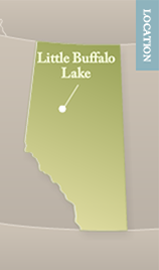
Billy Joe Laboucan | Woodland Cree | Little Buffalo Lake
Cree linguist Billy Joe Laboucan shares his understanding of the circle as a symbol for indigenous people.
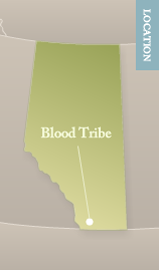
Wilton Goodstriker | Kainai | Blood Tribe
Elder Wilton Goodstriker shares his Kainai perspective on the meaning and use of the peace pipe.
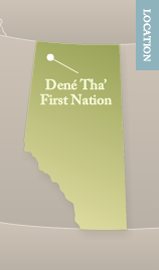
William Yatchootay | Dené Tha’ | Dené Tha’ First Nation
William Yatchootay, Dené Tha’ Elder from Meander, speaks in Dene about receiving traditional drum knowledge. At the right time he will pass the drum onto someone he feels worthy to carry on the community role of drummer/singer.
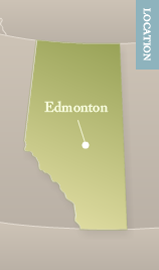
Xavier Batoche | Métis | Métis Nation of Alberta Region 4
Xavier Batoche, Métis Elder and artisan, speaks about the roots of Métis culture.
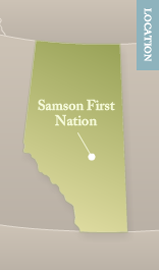
Kevin Buffalo | Plains Cree | Samson First Nation
Kevin Buffalo, Cree teacher and Chicken Dancer, talks about the importance of traditional dance.
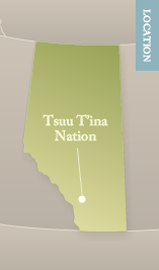
Ellery Starlight | Tsuu T’ina | Tsuu T’ina Nation
Ellery Starlight, Tsuu T’ina Nation, explains the significance and meaning of wearing braids.

Infusion Through Art
Students and teachers explore culture and identity through a variety of First Nation, Métis and Inuit art forms: painting with Métis visual artist Aaron Paquette, crafts with Elder Francis Whiskeyjack, contemporary art with teacher Reka Serfozo from Amiskwaciy Academy, Edmonton, and traditional flint knapping with Bob Silverthorne, teacher at Centennial Elementary, Westaskiwin.
Select a resource type from the list.
Web Links
While some First Nations, Métis and Inuit experts have recommended these web links, they are not authorized by Alberta Education.
What is Rock Art and where can I see it? (FAQs) Royal Alberta Museum.
Rock art is a term used to describe pictographs (paintings on rock walls using red ochre, water and animal grease) and petroglyphs (carvings etched into rocks). This overview of rock art tells you where to see it in Alberta and how it is being preserved.
Saskatchewan Indigenous Portal. University of Saskatchewan Library
The Indigenous Studies Portal (iPortal) provides a place to find electronic resources for Indigenous studies. Books, articles, theses, documents, photographs, archival resources and maps are available. A special feature is a map of First Nations in Western Canada with links to resources related to specific First Nations.
The Virtual Museum of Métis History and Culture. Gabriel Dumont Institute of Native Studies and Applied Research
This comprehensive website chronicles traditional Métis history and culture and contains a wealth of primary documents, including interviews, photographs and archival materials in print, audio and video files. Six categories identify themed collections on artistic expressions, celebrations, indigenous voices, heritage, learning resources and additional links.
The Rock Art Archive of Canada. Bradshaw Foundation.
This archive site provides an introduction to the rock art pictographs and petroglyphs located across Canada and provides examples from rock art sites in Alberta and British Columbia areas.
Áísínai'pi National Historic Site of Canada / Writing-on-Stone Provincial Park Rock Art. Alberta Parks.
Much of the Writing-on-Stone Provincial Park / Áísínai'pi National Historic Site is a protected archaeological preserve within Blackfoot territory and access to the rock art sites is only available by park tours. This information pamphlet provides park notes to support visitors and learn about the First Nations culture and stories behind the images.
Documents
While some First Nations, Métis and Inuit experts have recommended these documents, they are not authorized by Alberta Education.
Cultural Traditions. Education Is Our Buffalo. Alberta Teachers’ Association
This overview of First Nations, Métis and Inuit traditions from the ATA publication Education Is Our Buffalo introduces symbols, protocols, celebrations, gift-giving, songs and dances.
Art & Community. Aboriginal Perspectives
Creative expressions function in many ways: they build community, record significant events, connect with the spiritual world and reinforce identity. This excerpt from Aboriginal Perspectives (Aboriginal Studies 10) presents information on creative expressions and on traditional art forms, such as quillwork, beadwork, tufting, birchbark biting, fish scale art, Inuit sculpture and performing arts.
Artwork. Aboriginal Perspectives Teacher Resource
This handout guides students in planning a collage, a diorama or a shield related to First Nation, Métis or Inuit cultures.
Symbols Web & Creative Expression Chart. Aboriginal Perspectives Teacher Resource
The Symbols Web is a graphic organizer that helps students organize information about symbols using these questions: Who uses the symbol? What is the spiritual message of the symbol? What is the history of the symbol? The Creative Expression chart supports student research on First Nation, Métis or Inuit cultures culture by focusing attention on forms, symbols, types of objects, materials and overall style.
Ceremonies
Ceremonies are ways that First Nations, Métis and Inuit demonstrate respect and gratitude for gifts from the physical and spiritual world. This excerpt from Aboriginal Perspectives (Aboriginal Studies 10) discusses the significance of ceremonies, and briefly describes communal ceremonies such as tea dances, round dances, sweat lodges and powwows.
Select a video from the list.
Young Artists
“My people will sleep for one hundred years, but when they awake, it will be the artists who give them their spirit back.” —Louis Riel, 1885
Several young First Nations, Métis and Inuit singers, musicians, dancers and visual artists discuss the significance of traditions and symbols in their work. These artists demonstrate a strong connection to their communities and their First Nations, Métis or Inuit identity. As they discuss what they have learned from family, Elders and ancestors, they exemplify the resilience of Inuit, Métis and First Nations peoples by bringing to life their symbols and traditions. When these artists perform or create, they draw inspiration from their culture.
Caslan Dancers
The community of Caslan is just north of the Buffalo Lake Métis Settlement.
This video, produced as part of an AISI project at Caslan School in Northern Lights School Division, shows how introduction of dance and fiddling to students had a positive effect on student attendance and on relationships with parents and the community.
Shirts Come Home for a Visit
In 1841 five Blackfoot Shirts were gifted to Sir George Simpson, Governor of the Hudson Bay Company. This film tells the story of the journey of the five Shirts to Oxford University in England and the results of their brief visit back to their Blackfoot homeland.
This video was produced by Narcisse Blood. A more detailed documentary of the entire Wars Shirts Project is under production.
While Narcisse Blood passed in 2015, we are privileged and honoured to still have his words to share.